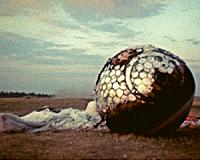 |
New Delhi (UPI) Feb 25, 2011 Boeing is looking to partner with India on manned space mission development, including making composite cryogenic fuel tanks for launch vehicles. Boeing can "provide value-added assistance to India's space program" because of its role in U.S space missions, including the space shuttle, Boeing's vice president in India for defense, space and security contracts, Vivek Lall, said. Cooperation is more likely now that the Indian Space Research Organization and the Defense Research and Development Organization have been removed from the Entity List, drawn up by the Bureau of Industry and Security, part of the U.S. Department of Commerce. The first Entity List was published in 1997. It informs the U.S. businesses about foreign organizations that may have engaged "in activities that could result in an increased risk of the diversion of exported, re-exported and transferred items to weapons of mass destruction programs." Of most concern are technologies or products that can be used for military purposes other than for which they were originally intended. Cryogenic technologies have been one such area. Removal of the ISRO and the DRDO came after U.S. President Barack Obama's visit to India in November. The two Indian government organizations are front-runners in the research and design of military equipment, including equipment for space programs, before the private sector is involved in mass production. Boeing submitted a formal request to the U.S. Department of State to move toward more cooperation "should our services be accepted," Lall told an Indian defense magazine. "But how forward the two countries go would depend upon what India wants and the bilateral agreements between the two governments. At the moment, we have indicated the intent to cooperate. It is up to ISRO now to tell us what it wants and we will do our best," Lall said. Composite cryogenic tanks, made of high-strength fibers embedded in a resin epoxy, are up to 30 percent lighter than aluminum containers and wear longer. The ISRO has worked with Russia, with varying degrees of success, to manufacture extremely strong and lightweight composite tanks to hold highly volatile rocket fuels including liquid methane and liquid hydrogen. Boeing is using such complex composite technology on its new 787 Dreamliner passenger jet, the Bell-Boeing V-22 Osprey tilt-rotor aircraft and unmanned aerial vehicles. Boeing's interest in greater engagement with India's space program comes also as the Indo-Russian joint venture and cruise missile developer BrahMos Aerospace eyes cryogenic work. BrahMos hopes to get the contract to manufacture a cryogenic engine -- one that uses cryogenic fuel -- once ISRO is ready to go to market, BrahMos Chief Executive A. Sivathanu Pillai told reporters in Chennai. "The ISRO is developing the cryogenic engine to power its GSLV (geosynchronous satellite launch vehicle) rockets," Pillai said. "Once ISRO perfects the technology, we will make the engine as the space agency has asked us to do it." BrahMos Aerospace is a joint venture between India's DRDO that holds 50.5 percent stake and the Military Industrial Consortium/MPO Machinostroyenia of Russia holding the remaining stake.
Share This Article With Planet Earth
Related Links Space Tourism, Space Transport and Space Exploration News
 Sotheby's To Auction Soviet Space Capsule
Sotheby's To Auction Soviet Space CapsuleMoscow, Russia (RIA Novosti) Feb 25, 2011 Sotheby's auction house announced on Thursday that it will auction a 1961 Soviet space capsule on April 12, the 50th anniversary of the first manned mission to space. The Vostok 3KA-2 spacecraft is the twin of the Vostok 3KA-3, which carried Yuri Gagarin into space. The 3KA-2 model lifted off 20 days before Gagarin's momentous flight carrying a cosmonaut mannequin (Ivan Ivanovich) an ... read more |
|
| The content herein, unless otherwise known to be public domain, are Copyright 1995-2010 - SpaceDaily. AFP and UPI Wire Stories are copyright Agence France-Presse and United Press International. ESA Portal Reports are copyright European Space Agency. All NASA sourced material is public domain. Additional copyrights may apply in whole or part to other bona fide parties. Advertising does not imply endorsement,agreement or approval of any opinions, statements or information provided by SpaceDaily on any Web page published or hosted by SpaceDaily. Privacy Statement |